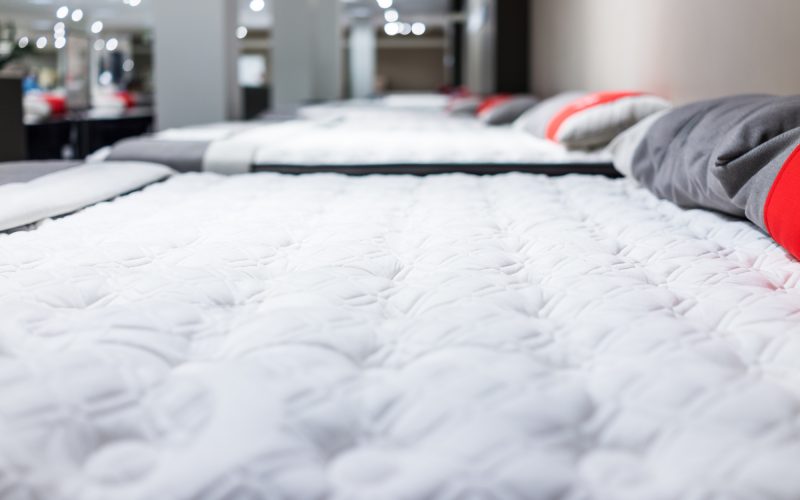When you are wondering how to pick the right mattress for you, you need to consider what position you commonly sleep in and what type of support you need and prefer.
Read on for a comprehensive bed buying guide that will help you know how to pick a mattress that will ensure a good night’s rest.
Read 5 hacks to help you get a restful sleep.
Bed Buying Guide
Before looking at materials and specifications, the first thing you need to consider is how you sleep.
Side, back, stomach. How do you best fall asleep and in what position do you wake up in? Every sleeping position has its own unique needs.
Side Sleepers
Side sleepers may sleep with legs straight, both or only one bent at an angle. If you sleep on your side, most of your weight is on your hip and shoulder. This means that you need a soft to medium mattress to relieve these pressure points.
On a scale of 1 to 10, with 10 being the most firm, side sleepers usually prefer a mattress in the 3-6 range.
A softer mattress means there is enough contour for the shapes of the body. Too firm and lower back, neck and shoulder pain are all likely the result.
Back Sleepers
Back sleepers need a firmer mattress than side sleepers. A too-soft mattress will cause pressure points on the sleeper resulting in back or neck pain.
Without enough support, back sleepers may have an improper spinal alignment which could lead to serious back problems.
The right mattress for you if you sleep on your back is usually in the 4-7 firmness range (where 10 is the most firm). This range will give you good support and be soft enough to relieve pressure points.
Stomach Sleepers
Just like back sleepers, insufficient support can cause back problems for stomach sleepers. If the mattress is too soft, the midriff section will sink in and cause the spine to curve in.
Stomach sleepers need a mattress that provides equal support across their entire body. Their body should be as flat as possible on top of the mattress.
A mattress in the 5-7 range (where 10 is the most firm) is usually the best choice for stomach sleepers.
Next, let’s consider the material of the mattress in our bed buying guide.
Latex Foam Mattress
Like the name suggests, these mattresses are made from latex foam. This material is known for its responsiveness, comfort, bounce, and cooling abilities.
These mattresses come in every type of firmness: soft, medium, medium-firm and firm.
Good for any type of sleep position. If you get hot while you sleep or roll around, this may be your best bet.
Memory Foam Mattress
Memory foam has much more body-contouring than latex foam. These beds also have excellent support and pressure relief.
Memory foam was first developed in the 1970’s by NASA as a safety material for seat cushions to protect pilots and passengers during plane crashes.
In the past, people complained that memory foam mattresses did not provide enough cooling. Nowadays, the cooling features are better in a memory foam mattress but it might not be enough if you sleep very hot.
If you prefer more “hug” from your bed, consider a memory foam mattress. Another great feature is that motion is isolated. So if your partner is rolling around, it will not disturb your slumber.
Innerspring (Coil) Mattress
Coil mattresses dominate the bed industry. They have been around forever and get better and better. Though lately, they seem to be getting a bad rep.
These mattresses have one or more layers of spring coils. More coils usually mean you get more comfort and support.
These beds have space between each spring that allows air to circulate. In turn, you get a cooler night’s sleep.
If you regularly sit or sleep on the edge on your mattress, coil mattresses provide un-paralleled edge support.
Do you have trouble falling asleep? Here are 15 hacks to fall and stay asleep. Visit W88 for a variety of club casino games.
Hybrid Mattress
Hybrid mattresses are made from a combination of the previous materials. You can get any combination of latex, memory foam, coils, and other materials.
These mattresses aim to maximize key benefits from each type of mattress and roll those into one bed. This is a good choice for many types of sleepers. However, the price may well be much higher.
For example, a latex + memory foam hybrid is able to deliver great bounce, cooling, and responsiveness via the latex, but also provide great pressure relief and support from the memory foam.
Pillow-Top Mattress
Like the hybrid, a pillow-top can be made of any of the previously mentioned materials. The only difference is that it has an extra layer of cushion in the cover for added comfort.
If you enjoy more padding and cloud-like plushness, a pillow-top mattress is likely the right pick for you.
Adjustable Mattress
As the name suggests, you can adjust the sleeping position of the mattress. You can elevate the feet or back.
This type of bed is best for anyone who snores, has chronic lower back pain or respiratory issues.
Read why you should see a chiropractor for pain management.
Final Thoughts
As you can see, there are lots of choices out there and several things to consider when buying your new mattress.
We hope that this bed buying guide has given you all the detailed information you may need to know to make an informed decision.
If you really have no idea where to start, go for a medium-firm mattress. Choose something with a score between 5 and 6 out of 10. Chances are that you are like the majority of people who would prefer a medium level of firmness.
Now, check out all our healthy living tips and hacks.
